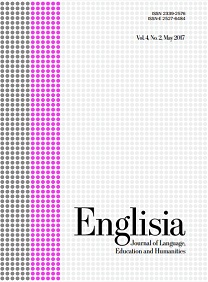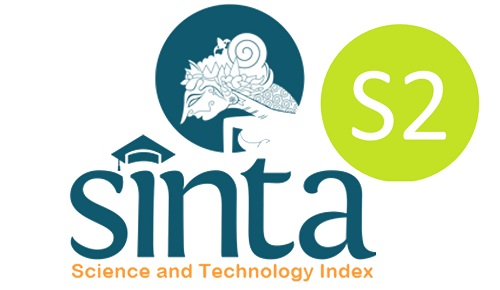Exploring higher order and lower order thinking skills in Indonesian junior high school ELT textbooks
DOI:
https://doi.org/10.22373/ej.v12i2.29201Keywords:
Critical thinking, Indonesian ELT textbook, HOTS, LOTSAbstract
English textbooks play a pivotal role in supporting English as a Foreign Language (EFL) learning, particularly for junior high school students. Critical thinking skills are essential for enhancing students’ English language proficiency. This study investigates the representation and frequency of Higher-Order Thinking Skills (HOTS) and Lower-Order Thinking Skills (LOTS) in instructional questions within the Grade VII Indonesian ELT textbook (2017 revised edition) published by Kemendikbud, widely used in Indonesian public schools. Employing a qualitative content analysis approach, this study utilized the revised Bloom’s Taxonomy to analyze the data, which were quantified into percentages and frequencies. Findings reveal a higher prevalence of LOTS compared to HOTS in the textbook’s instructional questions. Consequently, teachers are encouraged to creatively adapt these questions to foster critical thinking. Additionally, future textbook authors should prioritize integrating more HOTS-based questions to enhance students’ critical thinking skills in ELT contexts.Downloads
References
Abidasari, E., Sabgini, K. N. W., & Inayati, N. (2021). Bright English Textbook Development for Primary School Grade 6 in Batu City. PIONEER: Journal of Language and Literature, 13(1), 26. https://doi.org/10.36841/pioneer.v13i1.899
Alghamdi, A. (2022). Empowering EFL Students with 21st-Century Skills at a Saudi University: Challenges and Opportunities. International Journal of Education, Learning, and Development, 10(3), 39–53. https://doi.org/10.37745/ijeld.2013/vol10no3pp.39-53
Anasy, Z. (2016). Hots (Higher Order Thinking Skill) in Reading Exercise. TARBIYA: Journal of Education in Muslim Society, 3(1), 51–63. https://doi.org/10.15408/tjems.v3i1.3886
Anderson, L. W., & Krathwohl, D. R. (2001). A taxonomy for learning, teaching, and assessing: A revision of Bloom’s taxonomy of educational objectives: complete edition. Addison Wesley Longman, Inc.
Azizah, F. U., & Linggar Bharati, D. A. (2021). HOTS in Reading Activities of Modules 1 to 5 Easy English for Package B. English Education Journal, 11(4), 600–607. https://doi.org/10.15294/eej.v11i4.51533
Damayanti, I. (2019). An Evaluation of English Textbook for Grade X of Senior High School. International Seminar and Annual Meeting BKS-PTN Wilayah Barat.
Erdiana, N., & Panjaitan, S. (2023). How is HOTS integrated into the Indonesian high school English textbook? Studies in English Language and Education, 10(1), 60–77. https://doi.org/10.24815/siele.v10i1.26052
Febrina, F., Usman, B., & Muslem, A. (2019). Analysis of Reading Comprehension Questions by using Revised Bloom’s Taxonomy on Higher Order Thinking Skill (HOTS). English Education Journal, 10(1), 1–15.
Febriyani, R. A., Yunita, W., & Damayanti, I. (2020). An Analysis on Higher Order Thinking Skill (HOTS) in Compulsory English Textbook for the Twelfth Grade of Indonesian Senior High Schools. Journal of English Education and Teaching, 4(2), 170–183. https://doi.org/10.33369/jeet.4.2.170-183
Giri, P. A. L. P. N. (2021). Teachers’ Perception of HOTS-Based Learning in EFL Classroom. The Art of Teaching English as a Foreign Language, 2(2), 103–108. https://doi.org/10.36663/tatefl.v2i2.122
Huberty, C. J., & Davis, E. J. (1998). Evaluation of a state critical thinking skills training program. Studies in Educational Evaluation, 24(1), 45–69.
Kasim, U., Zulfikar, T., & Zaiturrahmi, Z. (2017). Analysis of Instructional Questions in an English Textbook For Senior High Schools. English Education Journal (EEJ), 8(4), 536–552.
Margana, M., & Widyantoro, A. (2017). Developing English Textbooks Oriented to Higher Order Thinking Skills for Students of Vocational High Schools in Yogyakarta. Journal of Language Teaching and Research, 8(1), 26–38. https://doi.org/10.17507/jltr.0801.04
Miles, M. B., Huberman, A. M., & Saldana, J. (2014). Qualitative data anlaysis: A methods sourcebook (3rd ed.). SAGE Publications, Ltd.
Nurhayati, N., & Fairuz, T. (2023). Analysis of Higher Order Thinking Skills (HOTS) Content on Students’ Textbook of Natural and Social Sciences Subject for grade V Elementary School. EduLine: Journal of Education and Learning Innovation, 3(1), 90–95. https://doi.org/10.35877/454RI.eduline1536
Poedjiastutie, D., Akhyar, F., Hidayati, D., & Nurul Gasmi, F. (2018). Does Curriculum Help Students to Develop Their English Competence? A Case in Indonesia. Arab World English Journal, 9(2), 175–185. https://doi.org/10.24093/awej/vol9no2.12
Rindawati, R., Ikhsanudin, I., & Wardah, W. (2014). An Analysis on English Textbook “Bahasa Inggris: When English Rings the Bell.” Jurnal Pendidikan Dan Pembelajaran Khatulistiwa, 3(9), 1–13.
Schilling, J. (2006). On the Pragmatics of Qualitative Assessment. European Journal of Psychological Assessment, 22(1), 28–37. https://doi.org/10.1027/1015-5759.22.1.28
St. Pierre, E. A., & Jackson, A. Y. (2014). Qualitative Data Analysis After Coding. Qualitative Inquiry, 20(6), 715–719. https://doi.org/10.1177/1077800414532435
Sucipto, S., & Cahyo, S. D. (2019). A Content Analysis of the Reading Activities in “Bright 2”an English Textbook for Junior High School Students. English Language Teaching Educational Journal, 2(1), 13. https://doi.org/10.12928/eltej.v2i1.918
Surono, S., Pratolo, B. W., & Hanun, S. L. (2023). Analysis of HOTS and LOTS of instructional questions in the English textbook “When English Rings a Bell” for grade VIII. English Language Teaching Educational Journal, 5(3), 240–252. https://doi.org/10.12928/eltej.v5i3.8168
Theresia, M. (2021). TEACHERS’ QUESTIONS AND TESTS IN RELATION TO STUDENTS’ HIGH ORDER THINKING SKILLS IN ENGLISH DEPARTMENT. Satya Widya, 36(1), 9–24. https://doi.org/10.24246/j.sw.2020.v36.i1.p9-24
Tyas, M. A., Nurkamto, J., & Marmanto, S. (2020). CULTIVATING STUDENTS’ HIGHER-ORDER THINKING SKILLS IN EFL CLASSES: THE ROLE OF THE TEACHER AND THE TEXTBOOK. International Online Journal of Education and Teaching (IOJET), 7(1), 267–276.
Yeung, S. S. (2015). Conception of teaching higher order thinking: perspectives of Chinese teachers in Hong Kong. The Curriculum Journal, 26(4), 553–578. https://doi.org/10.1080/09585176.2015.1053818
Zainil, Y., Rosa, R. N., & Fitrawati. (2020). An Analysis of Reading Comprehension Questions in English Textbooks for SMAN Kota Padang: HOTS. Proceedings of the Eighth International Conference on Languages and Arts (ICLA-2019), 76–80. https://doi.org/10.2991/assehr.k.200819.015
Downloads
Published
Issue
Section
License
Copyright (c) 2025 Dinda Bunga Shabrina

This work is licensed under a Creative Commons Attribution 4.0 International License.
Proposed Policy for Journals That Offer Open Access
Authors who publish with Englisia journal agree to the following terms:
- Authors retain copyright and grant the journal right of first publication with the work simultaneously licensed under a Creative Commons Attribution License that allows others to share the work with an acknowledgement of the work's authorship and initial publication in this journal.
- Authors are able to enter into separate, additional contractual arrangements for the non-exclusive distribution of the journal's published version of the work (e.g., post it to an institutional repository or publish it in a book), with an acknowledgement of its initial publication in this journal.
- Authors are permitted and encouraged to post their work online (e.g., in institutional repositories or on their website) prior to and during the submission process, as it can lead to productive exchanges, as well as earlier and greater citation of published work (See The Effect of Open Access).









